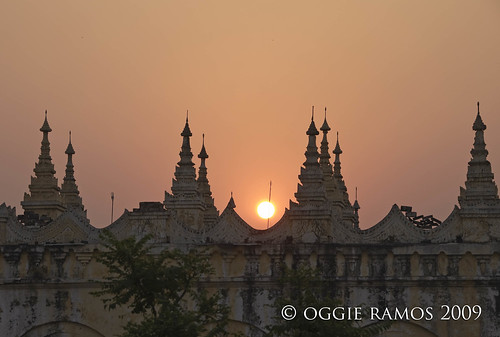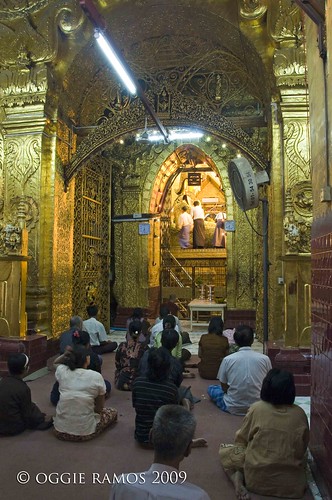 There were two stopovers during our 12-hour bus ride to Mandalay but I hardly remembered them save for making the obligatory alighting off the bus for dinner and post-midnight snacks. Then it's back to dreamland again. The bus resembles the ones plying EDSA, only older, but they were comfy and cool enough considering older traveler accounts that tell of non-aircon buses with hard seats.
There were two stopovers during our 12-hour bus ride to Mandalay but I hardly remembered them save for making the obligatory alighting off the bus for dinner and post-midnight snacks. Then it's back to dreamland again. The bus resembles the ones plying EDSA, only older, but they were comfy and cool enough considering older traveler accounts that tell of non-aircon buses with hard seats.It wasn't light yet when we arrived in Mandalay. By then, I made up my mind to go straight to Bagan on the first bus I can get on so I can reach the farthest point in my itinerary and work my way back to Yangon according to bus skeds and availability.
 By luck, I bumped into friendly Cho Gyi who offered to help me get an 8.30am bus ride to Bagan. Meanwhile, he gave me an idea of visiting the Maha Muni Pagoda because it was still early. Good thing really as we caught the sun rising above the edifices across the pond of Maha Muni. It's an edifying experience witnessing the sun being born again in the horizon, draping the pagodas with increasing luminosity.
By luck, I bumped into friendly Cho Gyi who offered to help me get an 8.30am bus ride to Bagan. Meanwhile, he gave me an idea of visiting the Maha Muni Pagoda because it was still early. Good thing really as we caught the sun rising above the edifices across the pond of Maha Muni. It's an edifying experience witnessing the sun being born again in the horizon, draping the pagodas with increasing luminosity. The Maha Muni Pagoda is considered the most important religious structure in Mandalay. Cho Gyi likens it to the Shwedagon in Yangon in terms of iconic and religious significance. it is located around 3 kilometers south of the city center. The original pagoda was built in 1784, razed by fire a century after, and rebuilt later.
The Maha Muni Pagoda is considered the most important religious structure in Mandalay. Cho Gyi likens it to the Shwedagon in Yangon in terms of iconic and religious significance. it is located around 3 kilometers south of the city center. The original pagoda was built in 1784, razed by fire a century after, and rebuilt later.The much-revered Maha Muni figure which is 12 feet in height, has seen an interesting changing of hands -- it was taken as booty when the king of Bagan conquered part of Rakhaing in the 11th century but recovered by a force of 30,000 soldiers in 1784. Cast in metal, the statue is now covered with layers of gold leaf several centimeters thick -- a testament to how well venerated this statue is.
Info: the Maha Muni Pagoda is open to tourists from 6am-8pm • entrance fee: $4
